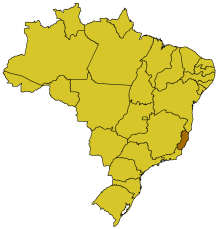|
|
For other places that have this name, see Espírito Santo (disambiguation)
| Statistics | |
|---|---|
| Capital: | Vitória |
| Area: | 46,184km² |
| Inhabitants: | 3,097,232 |
| Pop. density: | 58.5 inh./km² |
| Timezone: | GMT -3 |
| ISO 3166-2: | BR-ES |
| Governor: | Paulo Hartung |
| Map | |
 | |
| Contents |
Flag
The words in the central bar of the flag, Trabalha e Confia, translate to "Work and Trust [in ]". This motto is a truncated version of the Jesuit (well spreaded by José de Anchieta) motto "work as if everything depended on you, and trust as if everything depended on God", and was chosen by Jerônimo Monteiro. The flag was designed in 1908, with colours inspired by those of Saint Our Mother of Vitória's (Nossa Senhora da Vitória in Portuguese vestments.
Location
Map_of_Espirito_Santo_with_Capital_and_Neighbour_States.PNG
This Brazilian state is in the east of the southeastern subdivision of Brazil, which also contains the states of São Paulo, Minas Gerais and Rio de Janeiro. It is bordered by the Atlantic Ocean (E), the state of Bahia (N), the state of Minas Gerais (N) and (W), and the state of Rio de Janeiro (S). Espírito Santo's main cities (outside of the Greater Vitória region) are Cachoeiro de Itapemirim, Colatina, Guarapari, Linhares, Muniz Freire and Vila Velha.
Capixabas
There are doubts as to the origin of the term Capixabas, as those born in ES are called. It may derive from the name of a local tribe, from when the Portuguese arrived in the area during the colonial period. A more accepted explanation states that the local Amerindians gave the name to the inhabitants of Vitória island, which means plantation or even corn plantation, as plantations of various crops were interspersed with their houses. "Capixaba" is a word from "tupi Guarani" the native brasilians tribe language. It means " cabelo de milho" (Corn Hair) because when the Portuguese arrived they were blonde so their hair reminded the native people of the golden colour of the corn hair.
Ethnic groups
Amerindians
Capixabas represent today a great miscellany of races. For instance, the Amerindians have largely been absorbed into other Portuguese and African-origin Brazilians, and very few still live in reservations following subsistence farming methods and trying to preserve their fragile culture. A number of towns in Espírito Santo were founded with primarily Amerindian populations, such as Serra and Santa Cruz. Native food has made its way permanently into Capixaba life, featuring the fish-based Moqueca Capixaba as the state dish.
Italians
Espírito Santo is the Brazilian state with the largest amount of Italian-origin people. They founded many towns in the area and have a significant influence in Capixaba society. There are still a number of traditional Italian dance groups in the state and Italian culture festivals, such as the one held in the town of Venda Nova do Imigrante. Italian food is also a large part of Capixaba cuisine, and even industry. Italian cheeses like Mozzarella are produced locally, and pasta is also made, with Firenze Pastas being a local producer. Small scale farming, which had turned towards agrotourism, is today returning to Italian roots to exploit that market. This is another prominent aspect of Capixaba life.
Germans
A big local influence, Germans were among the first colonists to cultivate land away from the coastal zone. Like the Italian community, they still hold on to many aspects of their homeland culture, still having active traditional dance groups and festivals such as Sommerfest in Domingos Martins. Some groups still speak their native dialects, like the Pomeranian, and some still don't speak Portuguese.
History
Vitoria_Prefectural_Government_Building-ES.PNG
Espírito Santo was first inhabited by Amerindians, whose different tribes were usually semi-nomadic. The area was colonized by the Portuguese, and subsequently descendants of black slaves, and, later, by European immigrants of various origins.
Colonial Era
The area had been granted to Vasco Coutinho just after the discovery of Brazil in 1500. He arrived in the district (capitania, in Portuguese) of Espírito Santo on May 23 1535, bringing 60 soldiers, slaves and servants with him.
The capital of the district was at first Vila Velha, but because of frequent raids by Amerindians, it was moved to the current capital of Vitória, founded on September 8 1551, on an island near Vila Velha.
In 1556, after the arrival of missionaries, Serra, Nova Almeida and Santa Cruz were founded.
Political history
The district remained under the influence of Coutinho's family for 140 years. It remained a district for 287 years until 1821, when it became a province.
With the Brazilian declaration of independence in 1822, the District Directors became known as Provincial Presidents. In the same way the district of Espírito Santo became Espírito Santo Province. During this period in 1860 the Emperor Peter II, who was on good terms with the provincial President, visited the state on one of his tours of Brazil. There are still surviving accounts of what he saw and recorded.
In 1889, with the advent of the Brazilian Republic, Espírito Santo finally became a state.
After the adoption of a republican system, Afonso Cláudio de Freitas Rosa became the first governor of Espírito Santo state. He was followed in 1892 by Muniz Freire who served two terms, followed by Jeronimo Monteiro, who stayed in office from 1908 to 1912.
After Getúlio Vargas took power, the governors were elected by the national congress, and after this, a number of interveners were sent to govern the state. A short period of democracy returned when Carlos Monteiro Lindenberg was elected by Capixabas. However, after the 1964 military coup interveners were once again chosen by the national assembly. After Cristiano Dias Lopes, Arthur Carlos Gerhard Santos, Elcio Álvares and Eurico Rezende were chosen this way, open elections were used to choose all leaders from Gerson Camata through to José Inácio Ferreira, who came into office in 1999.
Economics
During the first 300 years, the main cash crop was sugarcane, until 1850 when coffee, in high demand by Europeans, overtook it. During the colonial era, there were also periods of "gold rush" when agriculture was neglected, leading to food shortages, but not much gold was found in Espirito Santo. Another factor that impeded expansion was the prohibition of roads opening into Minas Gerais, where it was feared smuggling would be encouraged through Espírito Santo.
Geography
Map_of_Espirito_Santo_Geography.PNG
At 46.180 square kilometres, it is about the size of Estonia, and has a variety of habitats including coastal planes, lakes, mountain forest, mangroves and many others.
The islands of Trindade and Martim Vaz, 715 km East of Vitória in the Southern Atlantic Ocean, also belong to Espirito Santo state.
Topography
The state can be divided into two areas: the low lying coastline and the highland area known as Serra (where one can find the 2,890 m Pico da Bandeira mountain), which is part of the larger Serra do Caparaó, the Caparaó Highlands. In the map to the right it is in the gray area in the extreme southwest of the state, and is shared with Minas Gerais.
Domigos_Martins_Mountains_small.PNG
Rivers
The main river in the state is the Doce. Other important river basins include the Santa Maria River Basin which is the northern branch of rivers which join the sea at Vitoria, and Jucu River Basin which flows into the sea at roughly the same place, but corresponds to the southern branch (which seems to come out of Vitoria). (See also Espírito Santo Municipalities)
Lakes
One of the most important lake districts in Brazil lies on the banks of the Doce river. The area contains some 26 large lakes, the biggest of which is called Juparanã Lake.
Climate
Espírito Santo's climate is generally dry and hot north of the Doce river, and with cold mountain climates in the south-south west. It is hot subtropical along the coast, with dry winters and rainy suummers.
Economy
The main crops of the state are rice, coffee (one of the most important cash crops in Brazil), cacao, sugarcane, beans, fruit (mostly bananas and papayas), and maize. The livestock industry, important throughout Brazil, is primarily cattle raised for milk and beef. Industry consists mainly of canning, forestry, textiles, iron and steel works. The latter two are concentrated around Cariacica and the "Vale do Rio Doce" ironworks.
Vitória is an important port for exporting iron and steel. Indeed, it is the biggest steel producer in the world. In São Mateus, petroleum reserves have been found on its continental shelf, and today are being commercially exploited.
Tourism plays an ever-increasing role in the state economy. However, most of the visitors are from neighbouring states, rather than foreign countries. Popular destinations include coastal areas such as Guarapari, Jacaraípe and Manguinhos, but mountain retreats such as Domingos Martins are also popular. Guarapari is also a local tourist destination, known for its curative black sand beaches.
Municipal capitals within Espírito Santo
(See also Espírito Santo Municipalities)
- Afonso Cláudio
- Água Doce do Norte
- Águia Branca
- Alegre
- Alfredo Chaves
- Alto Rio Novo
- Anchieta
- Apiacá
- Aracruz
- Atílio Vivácqua
- Baixo Guandu
- Barra de São Francisco
- Boa Esperança
- Bom Jesus do Norte
- Brejetuba
- Cachoeiro de Itapemirim
- Cariacica
- Castelo
- Colatina
- Conceição da Barra
- Conceição do Castelo
- Divino de São Lourenço
- Domingos Martins
- Dores do Rio Preto
- Ecoporanga
- Fundão
- Governador Lindenberg
- Guaçuí
- Guarapari
- Ibatiba
- Ibiraçú
- Ibitirama
- Iconha
- Irupi
- Itaguaçú
- Itapemirim
- Itarana
- Iúna
- Jaguaré
- Jeronimo Monteiro
- João Neiva
- Laranja da Terra
- Linhares
- Mantenópolis
- Marataízes
- Marechal Floriano
- Marilândia
- Mimoso do Sul
- Montanha
- Mucurici
- Muniz Freire
- Muqui
- Nova Venécia
- Pancas
- Pedro Canário
- Pinheiros
- Piúma
- Ponto Belo
- Presidente Kennedy
- Rio Bananal
- Rio Novo do Sul
- Santa Leopoldina
- Santa Maria de Jetibá
- Santa Teresa
- São Domingos do Norte
- São Gabriel da Palha
- São José do Calçado
- São Mateus
- São Roque do Canaã
- Serra
- Sooretama
- Vargem Alta
- Venda Nova do Imigrante
- Viana
- Vila Pavão
- Vila Valério
- Vila Velha
- Vitória.
| States of Brazil | 
|
|---|---|
| Acre | Alagoas | Amapá | Amazonas | Bahia | Ceará | Espírito Santo | Goiás | Maranhão | Mato Grosso | Mato Grosso do Sul | Minas Gerais | Pará | Paraíba | Paraná | Pernambuco | Piauí | Rio de Janeiro | Rio Grande do Norte | Rio Grande do Sul | Rondônia | Roraima | Santa Catarina | São Paulo | Sergipe | Tocantins | |
| Federal District: Brazilian Federal District | |
es:Espírito Santo no:Espírito Santo eo:Espirito-Santo ka:ესპირიტუ-სანტუ ja:ã¨ã¹ããªããµã³ãå· pt:Espírito Santo (estado)

